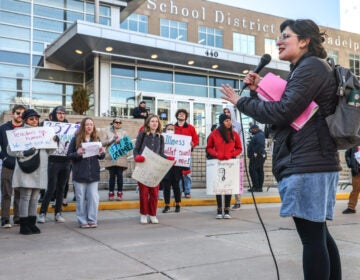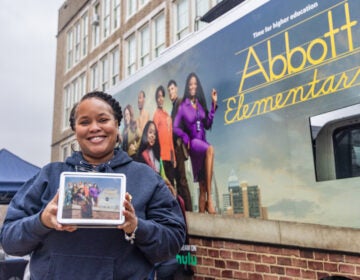As mediator decision looms, Philly school officials try to quell reopening fears
The superintendent argued that students need more academic and social support, citing data showing that younger kids aren’t making expected progress.
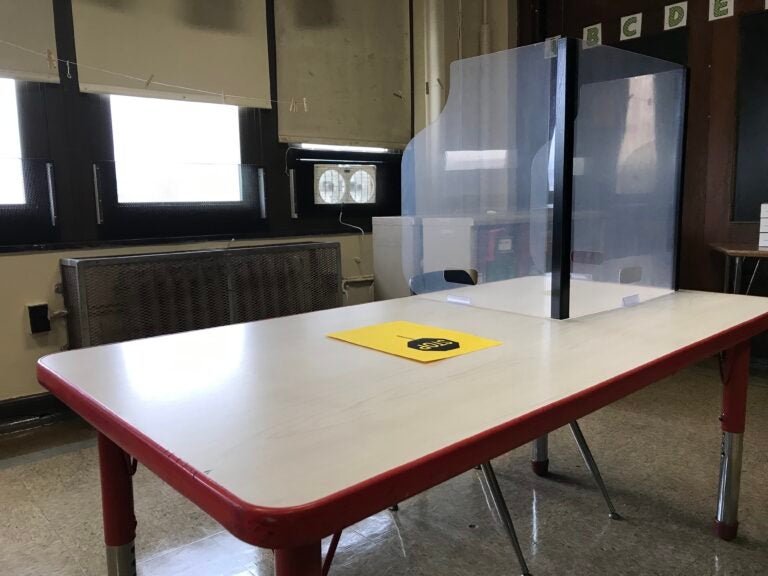
A socially distanced classroom at George W. Nebinger School in South Philadelphia. (Avi Wolfman-Arent / WHYY)
At a Thursday press conference, School District of Philadelphia officials defended their plans to bring some pre-K through grade 2 students back into classrooms on Feb. 22.
The event — which featured a tour of George W. Nebinger School in South Philadelphia — comes as the district and the Philadelphia Federation of Teachers meet with a mediator to determine if the district has met the conditions of a memorandum the parties signed last fall.
That memorandum lays out the conditions that must be met for school buildings to safely reopen, and includes guidelines around ventilation, cleaning, and protective supplies.
Superintendent William Hite said that the mediation sessions began Wednesday, about a week later than he’d hoped. Hite said that the district invited a state mediator to help bring “all sides” to the table and begin the hearings with Dr. Peter Orris, who will rule on the actual issue.
“We still don’t have a timeline,” Hite said. “The mediation is happening right now.”
After that ruling is made, it’s still unclear how the building reopening process will proceed.
“I don’t know what happens next,” said Hite.
But Thursday’s event seemed geared at making the case for students to be back in schools and quelling public fears about the district’s return plan.
Many parents and staff say that local COVID transmission rates — while dropping — are still too high. And they’ve directed considerable ire at the district’s ventilation plans, which include the installation of window fans in 32 buildings that don’t have effective mechanical ventilation systems.
District officials showed reporters those fans Thursday, and Hite stood by them in his remarks.
“Our priority is safety — not elegance or beauty,” said Hite. “[Fans] effectively bring in air from outside without causing disruption in the classroom.”
In the rooms showcased on the tour, the fans were relatively quiet and the rooms remained temperate. Building engineers will check rooms multiple times throughout the day to ensure that they’re at least 68 degrees, Hite claimed.

Hite also argued that students — especially younger ones — need the academic and social support that in-person school provides. He cited data showing that younger students aren’t making expected progress on reading. And he told a story about a 6-year-old who was learning under the cash register at her mother’s work because the family could not find affordable childcare.
“That’s not the type of educational environment we want our young people exposed to,” Hite said. “We think the best and safest place for them would be in schools.”
Right now, Hite said, more than 9,000 students are expected to return to classrooms two days per week starting on Feb. 22. Eligibility to return was based on a survey from the fall, where about one-third of parents opted into a hybrid education option. (Another one-third declined the option and a final third did not respond.)
Families who’ve opted into face-to-face learning are allowed to withdraw at any time, but Hite said “not many individuals” have done that so far.
Although nearly everyone agrees that full in-person learning is better academically than all-virtual options, some wonder whether the district’s hybrid model will stretch teachers too thin. They’ll have to juggle face-to-face instruction with the demands of students learning from home.
At Nebinger, for instance, only about a quarter of K-2 students opted for face-to-face learning. That group will be split in two cohorts that won’t be in the building on the same day. If divided evenly. That would mean no more than 22 students would report to Nebinger at a time.
The district has installed video cameras and large screens at the front of classrooms, which officials say will allow teachers to simultaneously teach one lesson to students both in-person and online.
Questions about safety and risk loom over the entire discussion.
The district has pointed to Centers for Disease Control studies and local health department guidance as proof that schools can safely open their doors.
“We’re entering a moment where it’s more possible than ever,” said Dr. Susan Coffin, an infection control specialist with the Children’s Hospital of Philadelphia, which advocated recently for in-person learning. “One thing we have on our side is experience and knowledge. We have the foundation and the knowledge about what are those key elements that will help keep us safe.”
But many in the public — the Philadelphia Federation of Teachers forefront among them — question the district’s ability to safeguard staff and children. And they worry new variants of COVID-19 will lead to further surges.
The PFT has said teachers should be vaccinated before returning to buildings — a process that will begin late this month.
Hite, meanwhile, seemed eager to move the reopening process forward. Appearing somewhat impatient, Hite even suggested that schools without window fans reopen first if that’s a key sticking point in the mediation.
“If it’s the 32 schools that have fans in the windows [that are the problem], then let’s bring everybody else back,” Hite said.

Get daily updates from WHYY News!
WHYY is your source for fact-based, in-depth journalism and information. As a nonprofit organization, we rely on financial support from readers like you. Please give today.



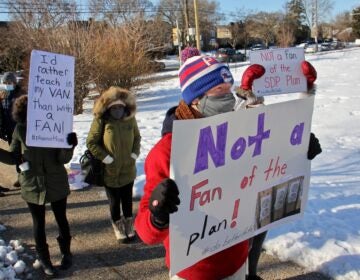
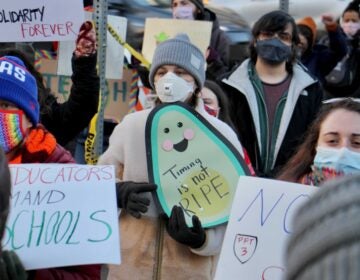
![CoronavirusPandemic_1024x512[1]](https://whyy.org/wp-content/uploads/2020/03/CoronavirusPandemic_1024x5121-300x150.jpg)

